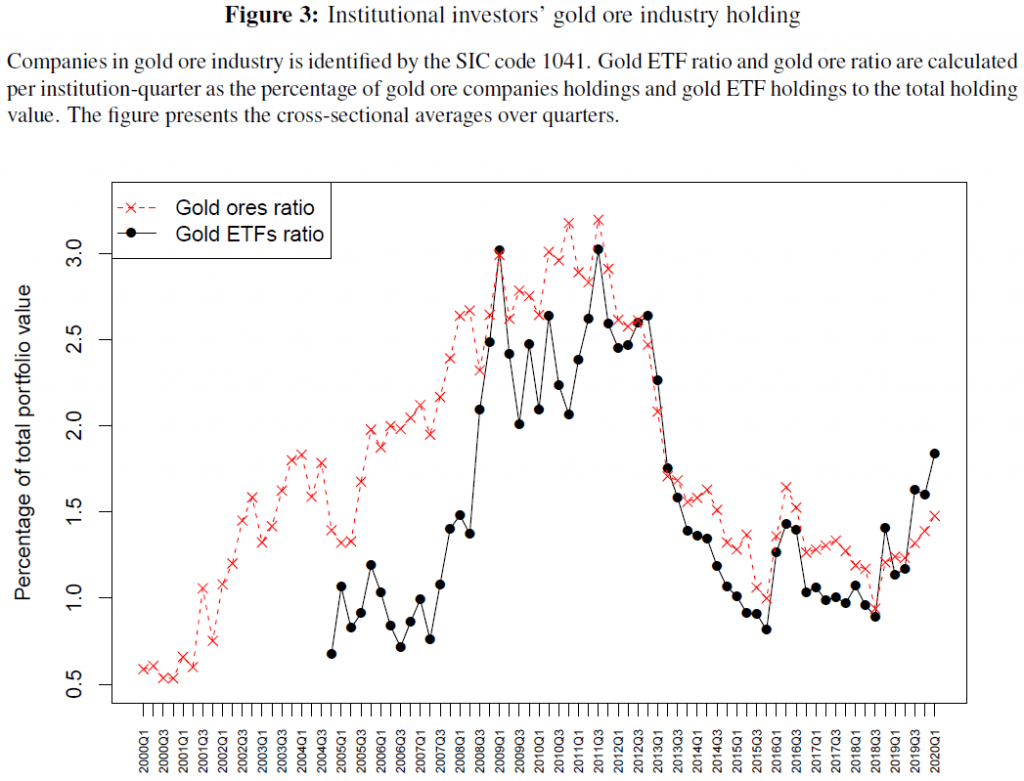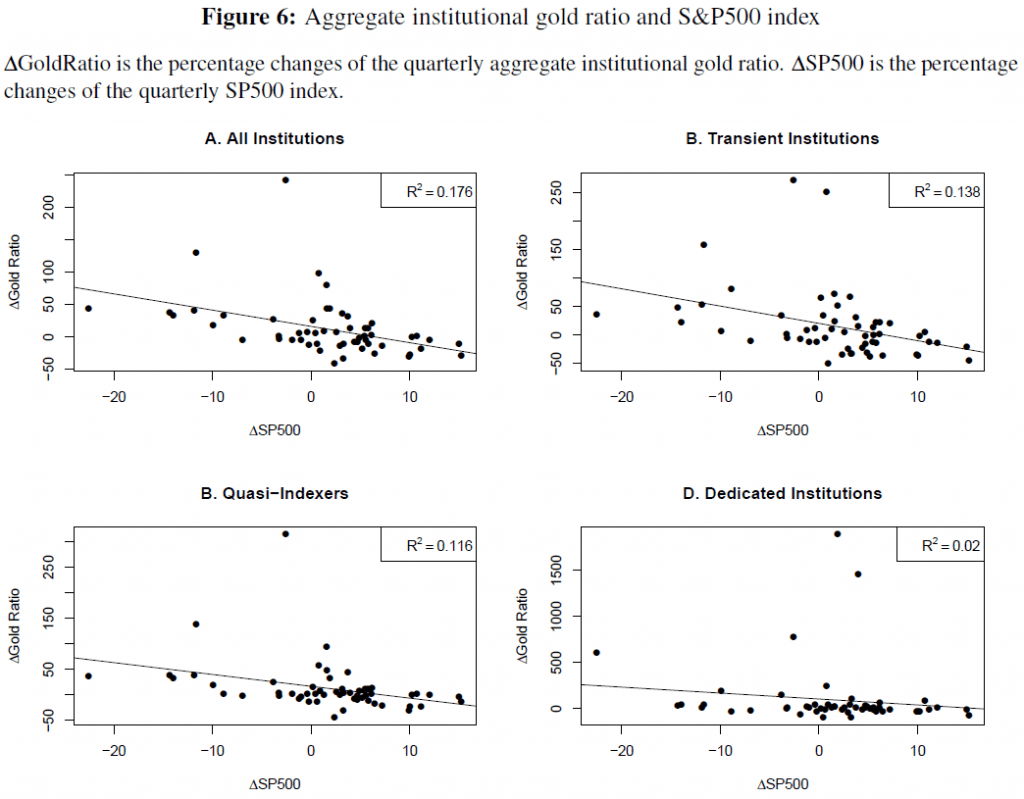
Ray Dalio, the founder of Bridgewater Associates L.P. and the creator of the All-Weather investment strategy, recommends having some gold in a contemporary environment. He states, “In a world of ongoing pressure for policymakers across the globe to print and spend, zero interest rates, tectonic shifts in where global power lies, and conflict, gold has a unique role in protecting portfolios. It’s wise to hold some gold.” Therefore, one would ask a question, what is the optimal weight of gold in a portfolio?
The novel study of Baur, Hoang, Casavecchia (2021) answers this question and examines the gold exposure of institutional investors and its performance implications. The results have shown that 30% of examined institutions have at least some gold allocation in their portfolios. While the allocation varies across time and institutions, the average gold-holding institution has a gold exposure of 1.7%. When compared to the average security weight in an institutional portfolio of 0.4%, the gold position looks a considerable one. Besides, institutions increase (decrease) their gold position when the stock market falls (rises). Consistent with the flight-to-quality effect, gold investors increase their gold allocation, and new investors come to the gold market when volatility increases. Moreover, the institutional portfolios with gold exposure outperform (underperform) during the stock market downtrend (uptrend). This negative relationship suggests that gold may retain its role as a safe haven despite the rising popularity of other alternative assets such as cryptocurrencies.
Authors: Dirk G. Baur, Lai T. Hoang, and Lorenzo Casavecchia
Title: The Gold Exposure of Institutional Investors
Link: https://papers.ssrn.com/sol3/papers.cfm?abstract_id=3899750
Abstract:
What is the optimal weight of gold in an investment portfolio? Suggestions range from 0% to more than 20%, but there is no study that systematically investigates this issue. We analyze the gold holdings (gold ETFs) of institutional investors based on 13-F filings and find that 30% of all institutions have at least some exposure to gold in their portfolio, with an average percentage holding of 1.7% with large differences across institutions and over time. The results further identify key determinants of gold holdings and demonstrate that gold holdings positively affect the performance of institutional investor portfolios.
As always we present several interesting figures:



Notable quotations from the academic research paper:
“The value of the above-ground gold is about 12 trillion US dollar at a 2,000 US dollar gold price and represents roughly 5% of the global market capitalization of both the equity market and the high-grade bond market. Given the size of the gold market and the importance of gold as an alternative asset class, it is remarkable that there is only limited information about institutional investors’ gold holdings and, perhaps as a consequence, no comprehensive study on this topic to date. To the best of our knowledge, this is the first study to examine the gold holdings of institutional investors, the importance of such holdings for portfolio insurance and their implication for the performance of institutional investor portfolios.
Our analysis provides interesting insights into the role of gold as a safe haven asset. While the previous literature has inferred gold holdings and gold properties indirectly from gold prices and correlations with other asset classes, we are able to directly observe gold holdings of institutional investors. For example, when the price of gold increases in response to a large stock market shock or at the beginning of a financial crisis, it is generally not known whether existing gold investors buy more gold or whether new investors buy gold and thus broaden the investor base. We observe an increase in terms of both depth (i.e., percentage gold holdings of existing investors) and breadth (i.e., number of new investors holding gold) of ownership of institutional investors.
About one third of all institutional investors in our sample hold gold, with an average portfolio weight of about 2%. This average varies across time and across institutions with some institutions allocating at times as much as 100% of their portfolio to gold ETFs. The number of institutions holding gold ETFs also varies through time, increasing sharply during periods of market stress consistent with a “flight to gold”. For instance, the average percentage gold holding increased from 1.5% to 2.5% between the first and the last quarter of 2008. We observe similar findings during other major crises or shocks such as the Eurozone sovereign debt crisis in 2011 and in the aftermath ofthe Brexit referendum in 2016.
Explicitly, institutional investors increase (decrease) their percentage gold holdings when the stock market falls (rises), on average. Interestingly, although investors holding gold ETFs underperform on average during normal market conditions, they outperform significantly during periods of market turmoil even after accounting for their risk-taking behavior. This result confirms that gold ETFs—and more generally physical gold—act as an asset class that offers valuable portfolio insurance and safe haven properties.
Our evidence resonates with the argument of Frazzini and Pedersen (2014) that many constrained institutional investors invest in leverage or inverse ETFs to alter the systematic risk exposure of their portfolios. Our findings suggest that gold holdings act as inverse ETFs thus allowing investors to deleverage their fund’s systematic risk exposure.
Our empirical evidence of gold being an important asset class in institutional investors’ portfolios suggests that gold still plays a critical role in investors’ asset allocation despite the growing popularity of alternative assets such as the “new gold” Bitcoin and other cryptocurrencies. Overall, our results suggest that gold is not a “barbarous relic” but a vibrant asset class that institutional portfolio managers use widely – and wisely – in both normal times and in crisis times.”
The evidence shows that gold remains a cornerstone in the investment strategies of institutional investors. Even with the rise of alternatives like Bitcoin and other cryptocurrencies, gold hasn’t lost its sheen. Far from being an outdated option, it continues to be a dynamic and trusted asset, skillfully utilized by portfolio managers in various market conditions. For individual investors aiming to tap into gold’s enduring value, especially for retirement planning, reaching out to a top company for Gold IRA can be a smart move. They’re the experts who can guide you through incorporating this classic asset into your retirement strategy.
Are you looking for more strategies to read about? Sign up for our newsletter or visit our Blog or Screener.
Do you want to learn more about Quantpedia Premium service? Check how Quantpedia works, our mission and Premium pricing offer.
Do you want to learn more about Quantpedia Pro service? Check its description, watch videos, review reporting capabilities and visit our pricing offer.
Are you looking for historical data or backtesting platforms? Check our list of Algo Trading Discounts.
Or follow us on:
Facebook Group, Facebook Page, Twitter, Linkedin, Medium or Youtube
Share onLinkedInTwitterFacebookRefer to a friend























